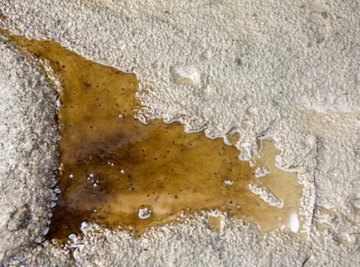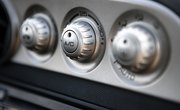
One of the benefits of a waste oil heater is that the fuel used (waste motor oil) is relatively inexpensive. Another benefit is being able to re-use something that would normally be considered garbage. Although the oil must still be pumped out of the ground, used motor oil has already been used once for its intended purpose. Any further use will help to keep it from contaminating the environment.
- Discarded electric water heater
- Cutting torch or electric saber saw
- Sheet metal
- Drill
- Pipe plugs
- Copper tubing
- Steel plate
- 6-inch cast iron frying pan
- 8-inch steel frying pan
- Pipe flanges
- 4-inch nipple
- Stove paint
- Pipe spacers
Make sure the discarded water heater being used is an electrically fired model. Gas burning heaters have vents running up the side that make conversion extremely difficult.
Do not use a galvanized metal tank. These can be identified by a silvery coating. Galvanized metal gives off toxic fumes when subjected to heat.
Do not try to restart a hot burner with kerosene. The vapors can cause an explosion.
Never use water to put out an oil fire. Keep a bucket of sand on hand to quench the flames if needed.
Remove the sheet metal covering and insulation from the electric water heater’s tank. Examine the tank for signs of corrosion. Discard the tank if excessive rust is present, and select another water heater. Place the tank on end. Rotate the tank so the seams and fittings are on the back side, opposite from where the access door will be.
Draw a 12-inch-by-12-inch rectangle on the front of the tank. This will be the location of the burner’s access door. Draw a circle 4 inches in diameter in the center of the top of the tank. This will be the location of the intake stack. Draw another circle 6 inches in diameter on the top of the tank, to the side of the 4-inch circle. This will be the location of the chimney stack. Cut all of the previously marked holes using a cutting torch or electric saber saw. Cut the intake and chimney holes slightly smaller than the marked circles, and file down the edges later to accommodate the intake and chimney pipes. Save the piece cut for the access door, as it will form the actual access door later.
Turn the tank over so that it’s resting on its top. Drill holes in the bottom of the tank to accommodate the pipe stand that will support the burner assembly. Bolt the pipe stand in place in the interior of the tank. Cut three or four legs for the tank from sheet metal. Position one of the legs on the bottom of the tank. Drill through the leg and the bottom of the tank. Bolt the leg in place. Repeat this procedure for the other legs. Turn the tank over again and stand it on the legs. Locate all of the pipe openings. Cap them with pipe plugs. Locate the holes where the heating elements entered the tank. Cut twice as many steel plates as there are heating element holes. Bolt one steel plate to the outside of each heating element hole. Bolt another steel plate to the inside of each heating element hole.
Drill a number of holes 1/4-inch in diameter in a cast iron frying pan that is 6 inches in diameter. The holes should be about an inch apart. Drill a number of holes 1/4-inch in diameter in a round piece of 1/4-inch steel plate. The holes should be about an inch apart. Drill four holes in the bottom of an 8-inch diameter steel frying pan. Bolt the steel frying pan to a pipe flange. Place two pipe spacers on the steel frying pan. Place the perforated steel plate on top of the pipe spacers. Place two more pipe spacers on the top of the steel plate. Place the 6-inch cast iron frying pan on top of the pipe spacers. Slide a long bolt through the holes in the top frying pan, the pipe spacers, the steel plate, the second set of pipe spacers, and the bottom frying pan. Secure the bolts with nuts. This will form the burner assembly. Attach a nipple four inches in length to the pipe flange located at the bottom of the burner assembly. Insert the burner assembly into the tank through the access door and screw the nipple onto the pipe flange on the bottom of the tank.
Insert a length of 6-inch diameter stovepipe into the previously cut hole in the top of the tank. This will form the chimney. Make sure the chimney extends at least six inches into the tank. Secure the chimney to the tank using bolts. Wrap soft copper tubing around the outside of the chimney three times. Position the lower end of the copper tubing directly above the burner assembly. Cover the copper tubing with 12 inches of 8-inch diameter stovepipe. Mount a 90-degree elbow of 4-inch stovepipe to the side of the 8-inch stovepipe, and place the end over the copper tubing’s lower end.
Attach an 18-inch length of 4-inch stovepipe to the end of the elbow pipe and place it in the intake hole on the top of the tank. Construct a funnel from sheet metal, and bolt it to the end of the 4-inch stovepipe inside the tank. Position the funnel over the burner assembly. The funnel should sit one inch above the top of the burner assembly. Bolt a frame to the inside of the access hole for the access panel to rest on. Secure the access door with latches. Paint the entire stove with high-temperature stove paint. Position the unit and bolt it in place to prevent tipping. Fill the burner assembly with ceramic fiber insulation. Fill the bottom of the furnace with sand.
Things You'll Need
Tips
Warnings
References
Tips
- Make sure the discarded water heater being used is an electrically fired model. Gas burning heaters have vents running up the side that make conversion extremely difficult.
Warnings
- Do not use a galvanized metal tank. These can be identified by a silvery coating. Galvanized metal gives off toxic fumes when subjected to heat.
- Do not try to restart a hot burner with kerosene. The vapors can cause an explosion.
- Never use water to put out an oil fire. Keep a bucket of sand on hand to quench the flames if needed.
About the Author
Mike Davey has been writing and editing professionally since 1996. His work has appeared in "Owl" magazine, "Sposa," "STUDENTBody" and numerous B2B publications such as "Collision Repair" magazine, "Canadian Rental Service" and "Glass Canada."
Photo Credits
Jupiterimages/Photos.com/Getty Images
